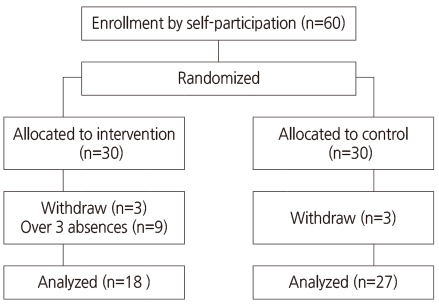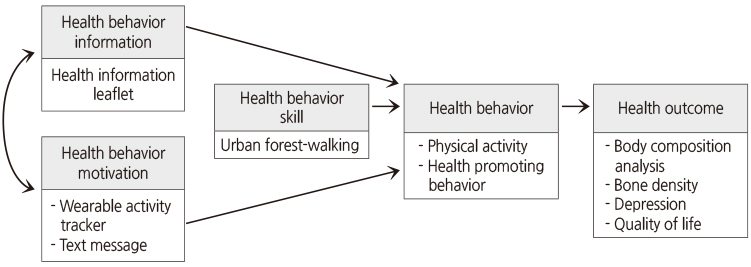The Effects of Urban Forest-walking Program on Health Promotion Behavior, Physical Health, Depression, and Quality of Life: A Randomized Controlled Trial of Office-workers
- Affiliations
-
- 1College of Nursing, Seoul National University, Seoul, Korea.
- 2The Research Institute of Nursing Science, Seoul National University, Seoul, Korea.
- 3College of Nursing, Seoul National University, Seoul, Korea. mk0408@snu.ac.kr
- KMID: 2373171
- DOI: http://doi.org/10.4040/jkan.2016.46.1.140
Abstract
- PURPOSE
This study was performed to determine the physical and psychological effects of an urban forest-walking program for office workers. For many workers, sedentary lifestyles can lead to low levels of physical activity causing various health problems despite an increased interest in health promotion.
METHODS
Fifty four office workers participated in this study. They were assigned to two groups (experimental group and control group) in random order and the experimental group performed 5 weeks of walking exercise based on Information-Motivation-Behavioral skills Model. The data were collected from October to November 2014. SPSS 21.0 was used for the statistical analysis.
RESULTS
The results showed that the urban forest walking program had positive effects on the physical activity level (U=65.00, p <.001), health promotion behavior (t= - 2.20, p =.033), and quality of life (t= - 2.42, p =.020). However, there were no statistical differences in depression, waist size, body mass index, blood pressure, or bone density between the groups.
CONCLUSION
The current findings of the study suggest the forest-walking program may have positive effects on improving physical activity, health promotion behavior, and quality of life. The program can be used as an effective and efficient strategy for physical and psychological health promotion for office workers.
Keyword
MeSH Terms
Figure
Cited by 3 articles
-
Comparison of Effects of Oral Health Program and Walking Exercise Program on Health Outcomes for Pregnant Women
Hae-jin Park, Haejung Lee
J Korean Acad Nurs. 2018;48(5):506-520. doi: 10.4040/jkan.2018.48.5.506.Effects of a Daily Life-Based Physical Activity Enhancement Program for Middle-Aged Women at Risk for Cardiovascular Disease
Kyung Ae Kim, Seon Young Hwang
J Korean Acad Nurs. 2019;49(2):113-125. doi: 10.4040/jkan.2019.49.2.113.Elementary School Teachers' Awareness of Forest Welfare Services and Promotion of Strategies for School-based Health Promotion Programs Using the Forest
Miju Kim, Kyung-Sook Bang, Insook Lee, Sungjae Kim, Yunjeong Yi, Young Ran Chin, Hyojeong Moon, Ei-Yan Ha
Perspect Nurs Sci. 2019;16(1):1-11. doi: 10.16952/pns.2019.16.1.1.
Reference
-
1. American College of Sports Medicine. ACSM's guidelines for exercise testing and prescription. 6th ed. Baltimore, MD: Lippincott Williams & Wilkins;2000.2. Shin WS, Yeoun PS, Lee JH, Kim SK, Joo JS. The relationships among forest experience, anxiety and depression. J Korean Ins For Recreation. 2007; 11(1):27–32.3. Lee HJ. Overwork-related mental illnesses, suicide and occupational accidents. Korean J Ind Relat. 2011; 21(4):133–156.4. Myatt G, Baxter R, Dougherty R, Williams G, Halle J, Stetts D, et al. The cardiopulmonary cost of backward walking at selected speeds. J Orthop Sports Phys Ther. 1995; 21(3):132–138. DOI: 10.2519/jospt.1995.21.3.132.5. Yoon JH, Lee HH, Kim YH. Analysis of energy expenditure and muscle fatigue during walking and running in obese women. J Sport Leis Stud. 2002; 18(2):1257–1269.6. Li Q, Kobayashi M, Inagaki H, Hirata Y, Li YJ, Hirata K, et al. A day trip to a forest park increases human natural killer activity and the expression of anti-cancer proteins in male subjects. J Biol Regul Homeost Agents. 2010; 24(2):157–165.7. Park BJ, Miyazaki Y. Physiological effects of viewing forest landscapes: Results of field tests in Atsugi city, Japan. J Korean For Soc. 2008; 97(6):634–640.8. Ji GB, Kim KN, Han GS. Physiological and psychological effects of viewing and walking in forest and urban area. J Environ Sci. 2012; 21(5):605–611. DOI: 10.5322/JES.2012.21.5.605.9. Seo HM, Hah YS. A study of factors influencing on health promoting lifestyle in the elderly: Application of pender's health promotion model. J Korean Acad Nurs. 2004; 34(7):1288–1297.10. Rhee MK, Lee YH, Park SH, Sohn CH, Chung YC, Hong SK, et al. A standardization study of Beck depression inventory I-Korean version (K-BDI): Reliability and factor analysis. Korean J Psychopathol. 1995; 4(1):77–95.11. Goldberg DP, Hillier VF. A scaled version of the general health questionnaire. Psychol Med. 1979; 9(1):139–145.12. Jang SJ. Stress. The Korean Society for Preventive Medicine. Standard study for data collection and survey of health statistical data. Seoul: Gyechuk Munwhasa;2000. p. 92–143.13. Ogilvie D, Foster CE, Rothnie H, Cavill N, Hamilton V, Fitzsimons CF, et al. Interventions to promote walking: Systematic review. BMJ. 2007; 334(7605):1204. DOI: 10.1136/bmj.39198.722720.BE.14. Abraham C, Graham-Rowe E. Are worksite interventions effective in increasing physical activity? A systematic review and meta-analysis. Health Psychol Rev. 2009; 3(1):108–144. DOI: 10.1080/17437190903151096.15. Choi HY, Yang SJ. Effects of walking program based on social cognitive theory for office workers. Korean J Adult Nurs. 2013; 25(6):712–724. DOI: 10.7475/kjan.2013.25.6.712.16. Conn VS, Hafdahl AR, Mehr DR. Interventions to increase physical activity among healthy adults: Meta-analysis of outcomes. Am J Public Health. 2011; 101(4):751–758. DOI: 10.2105/ajph.2010.194381.17. Hornbuckle LM, Bassett DR Jr, Thompson DL. Pedometer-determined walking and body composition variables in African-American women. Med Sci Sports Exerc. 2005; 37(6):1069–1074.18. Thompson DL, Rakow J, Perdue SM. Relationship between accumulated walking and body composition in middle-aged women. Med Sci Sports Exerc. 2004; 36(5):911–914.19. Lee MR, Kim WS. The effects of brisk walking versus brisk walking plus diet on triglycerides and apolipoprotein B levels in middleaged overweight/obese women with high triglyceride levels. J Korean Acad Nurs. 2006; 36(8):1352–1358.20. Roussel M, Garnier S, Lemoine S, Gaubert I, Charbonnier L, Auneau G, et al. Influence of a walking program on the metabolic risk profile of obese postmenopausal women. Menopause. 2009; 16(3):566–575. DOI: 10.1097/gme.0b013e31818d4137.21. Seo DI, Kim SK, Chang H. The effects of 12 weeks of walking exercise on body composition and physical fitness in middle aged women. J Korean Acad Public Health Nurs. 2009; 23(1):61–68.22. Sung KW, Lee JH. The effects of regular walking exercise on metabolic syndrome, cardiovascular risk factors, and depressive symptoms in the elderly with diabetic mellitus. J Korean Acad Community Health Nurs. 2010; 21(4):409–418. DOI: 10.12799/jkachn.2010.21.4.409.23. Kim KM, Lim HJ, Kim SH, Choi YH, Shin WS, Park BJ. The dfference of psychological relaxation effects between natural recreation forest and urban forest. J Korean Ins For Recreation. 2012; 16(1):53–58.24. Teychenne M, Ball K, Salmon J. Physical activity and likelihood of depression in adults: A review. Prev Med. 2008; 46(5):397–411. DOI: 10.1016/j.ypmed.2008.01.009.25. Bize R, Johnson JA, Plotnikoff RC. Physical activity level and health-related quality of life in the general adult population: A systematic review. Prev Med. 2007; 45(6):401–415. DOI: 10.1016/j.ypmed.2007.07.017.26. Haskell WL, Lee IM, Pate RR, Powell KE, Blair SN, Franklin BA, et al. Physical activity and public health: Updated recommendation for adults from the American College of Sports Medicine and the American Heart Association. Circulation. 2007; 116(9):1081–1093. DOI: 10.1161/circulationaha.107.185649.27. Abell JE, Hootman JM, Zack MM, Moriarty D, Helmick CG. Physical activity and health related quality of life among people with arthritis. J Epidemiol Community Health. 2005; 59(5):380–385. DOI: 10.1136/jech.2004.028068.28. Yamaguchi M, Deguchi M, Miyazaki Y. The effects of exercise in forest and urban environments on sympathetic nervous activity of normal young adults. J Int Med Res. 2006; 34(2):152–159. DOI: 10.1177/147323000603400204.29. Hartig T, Evans GW, Jamner LD, Davis DS, Gärling T. Tracking restoration in natural and urban field settings. J Environ Psychol. 2003; 23(2):109–123. DOI: 10.1016/S0272-4944(02)00109-3.
- Full Text Links
- Actions
-
Cited
- CITED
-
- Close
- Share
- Similar articles
-
- Influence of Depression and Social Support on Health-related Quality of Life among Migrant Workers: The Mediating Effect of Health Promoting Behavior
- Effects of a Remote Physical Activity Improvement Program on Male Office Workers with Metabolic Syndrome in Their 30s and 40s with Sedentary Behavior: A Randomized Controlled Trial
- The Effect of Work-site Health Promotion Program on Health Promoting Behavior, Cholesterol, and the Quality of Life of Middle-aged Workers
- Predictors of Quality of Life among Workers in Public Health Corporations
- Effects of the Health Status and Health Behavior on Health-related Quality of Life of the Elderly Living Alone and Living with Their Families: Using Data from the 2014 Community Health Survey



